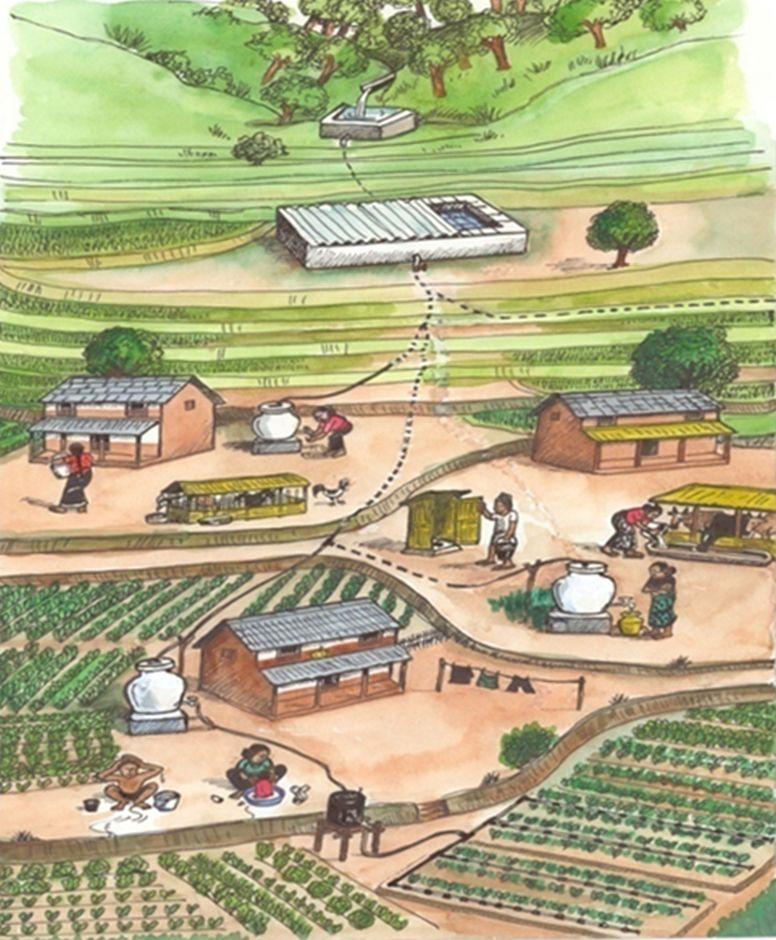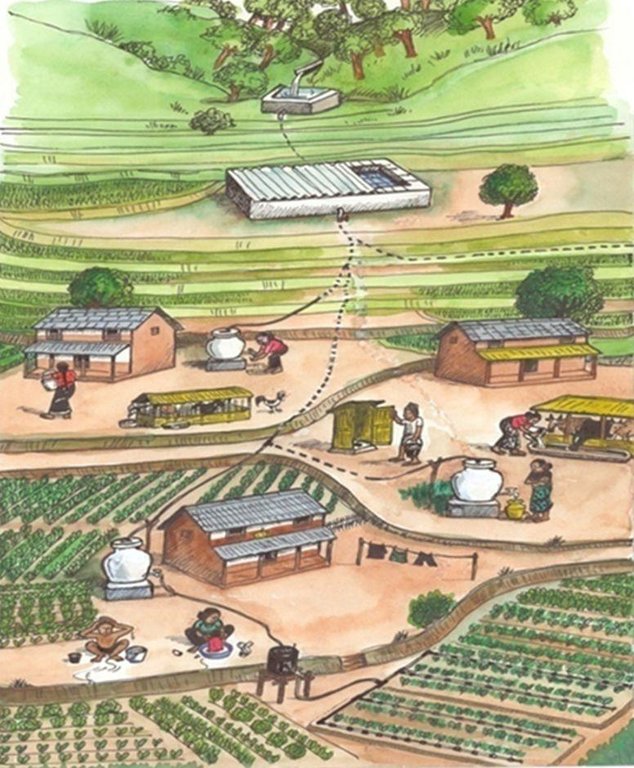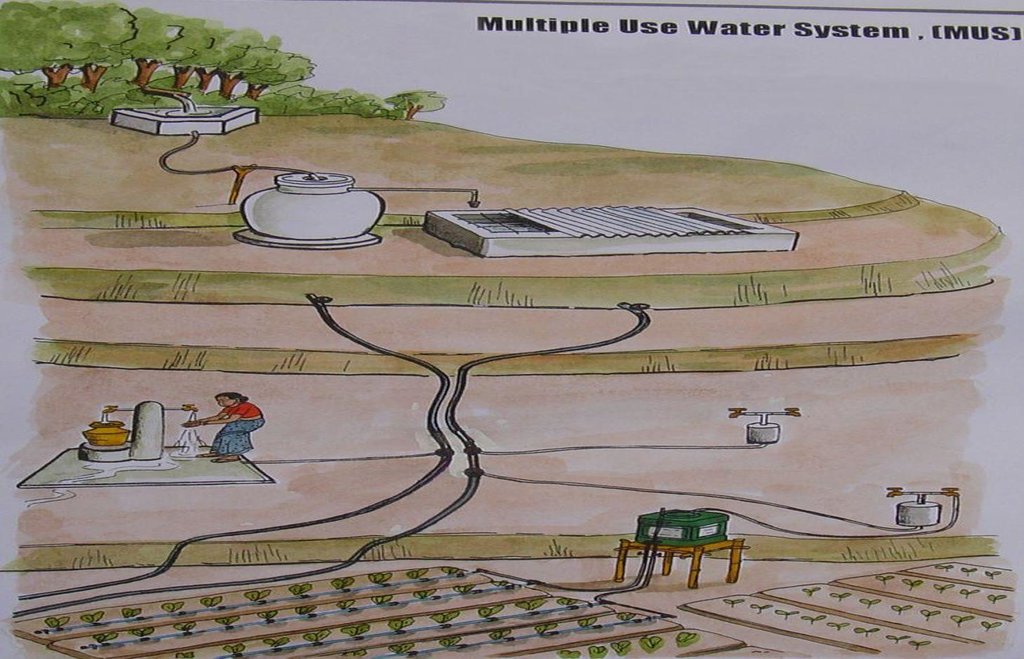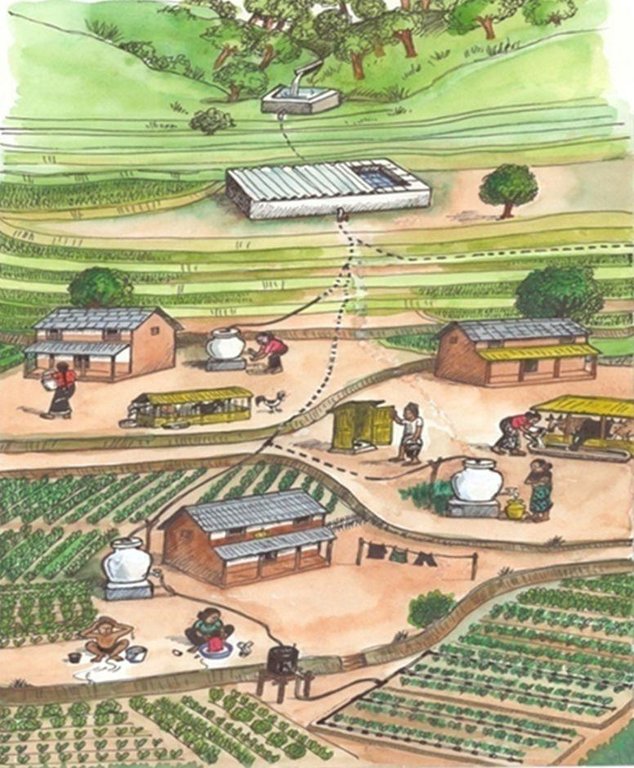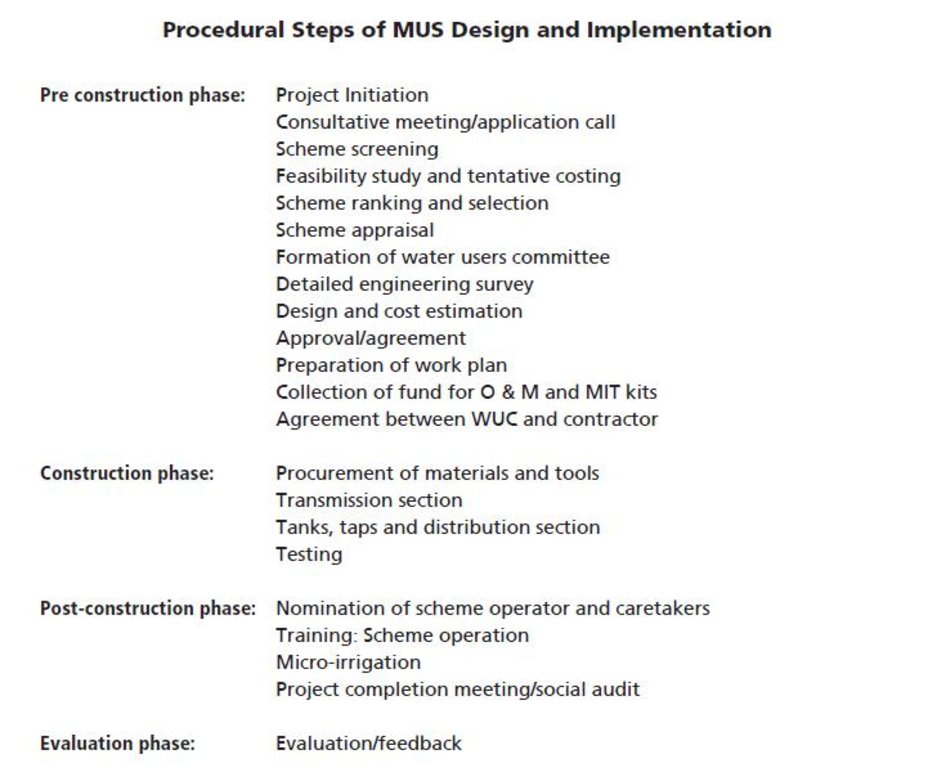A multiple-use water system [Непал]
- Создание:
- Обновить:
- Составитель: Shreedip Sigdel
- Редактор: –
- Рецензент: Fabian Ottiger
Bahu uddhasaya Pani prayog pranali (Main contributor: Parmananda Jha, IDE/Nepal)
approaches_2532 - Непал
Просмотреть разделы
Развернуть все Свернуть все1. Общая информация
1.2 Контактные данные специалистов и организаций, участвующих в описании и оценке Подхода
Специалист по УЗП:
Jha Parmananda
98487 28274 / 97495 12791 (M)
pjha@idenepal@org / jhap-2003@yahoo.com
Food Security Project, Regional Office, Banke Bagiya, Shantinagar,Nepalgunj
Непал
Название организации (-ий), содействовавших документированию/оценке Подхода (если применимо)
iDE Nepal (iDE Nepal) - НепалНазвание организации (-ий), содействовавших документированию/оценке Подхода (если применимо)
ICIMOD International Centre for Integrated Mountain Development (ICIMOD) - Непал1.3 Условия, регламентирующие использование собранных ВОКАТ данных
Когда были собраны данные (на местах)?
01/03/2013
Составитель и ответственный/-ые специалист(-ы) согласны с условиями, регламентирующими использование собранных ВОКАТ данных:
Да
2. Описание Подхода УЗП
2.1 Краткое описание Подхода
A multiple-use water system gives a community access to water for domestic use and water for crop irrigation.
2.2 Подробное описание Подхода
Подробное описание Подхода:
Aims / objectives: A multiple-use water system (MUS) is a combined water facility that has proven useful as a means of providing drinking water and water for irrigation for smallholder farmers in the hilly areas of Nepal. Water is collected by gravity from a highland source into a holding tank and is shared by means of distribution lines, domestic tap stands, and irrigation off-take lines. It can also support application of micro-irrigation technologies (MIT) such as drip and micro sprinkler irrigation systems.
Methods: MUS is a community-managed system that caters mainly to smallholder landowners and marginal households in rural hilly areas. When properly implemented, it can help to alleviate poverty and increase food security for poor and marginalized groups. The first priority is to provide drinking water and water for domestic use to the community; any excess water is used for agriculture and irrigation.
Stages of implementation: The following points should be taken into consideration before a community establishes a MUS:
• The source of water should be clear of water-rights issues
• The water should be plentiful and of good quality
• There needs to be a sufficient drop in gradient between the source and the tank if the water is to be collected by gravity. If the drop is not sufficient, users should be prepared to consider lifting the water.
• The distance between the source and the village should be less than 3 km.
• The community should be ready to contribute unskilled labour as part of their contribution to the project.
• The community should be ready to put aside some funds for operational and maintenance costs; these funds can, in part, also be collected in the form of monthly users' fees.
• At least 70% of the water users should be ready to adopt micro-irrigation technologies (MIT) such as drip and sprinkler irrigation.
2.3 Фотографии, иллюстрирующие Подход
2.5 Страна/ регион/ место, где применялся Подход
Страна:
Непал
Более точная привязка места:
Kaski, Lamjunj, Tanahun, Dhading, Sangjya, Gulmi, Arghakhanchi, Palpa, Udayapur, Pyuthan, Rolpa, Ruk
2.7 Тип Подхода
- в рамках проекта/ программы
2.8 Каковы цели/ задачи Подхода
The Approach focused mainly on other activities than SLM (Collect water from a small-scale source and distribute it both for domestic use and for the production of vegetables and high value crops)
• To provide a regular supply of water for domestic and agricultural use
• To supply water for micro-irrigation technologies such as drip and sprinkler irrigation systems
• To improve health and sanitation
• To help smallholder landowners improve their incomes and livelihoods as well as to adapt to climate change by having access to a regular supply of water so that they can grow crops regardless of changes
• To conserve water by using it more wisely
The SLM Approach addressed the following problems: The community needs to prioritize how it will partition the water for domestic use and for irrigation.
2.9 Условия содействующие применению Технологии/ Технологий в рамках Подхода или затрудняющие его
Социальные/ культурные/ религиозные нормы и ценности
- затрудняют
Management and operation of system
Treatment through the SLM Approach: Strong social mobilization is needed
Нормативно-правовая база (землевладение, права на земле- и водопользование)
- содействуют
The existing land ownership, land use rights / water rights helped a little the approach implementation: Since this approach uses small spring sources of water, there is usually only a minimum risk of conflict for water use. When the water source is registered with the local authorities, it helps to reduce potential conflicts over water rights between communities.
Осведомленность в области УЗП, доступность технической поддержки
- затрудняют
Water supply insufficient to meet the demand
Treatment through the SLM Approach: Increase the capacity of the storage tank
другие
- затрудняют
The community often cannot agree whether to scale up the domestic or the irrigation water supply.
Treatment through the SLM Approach: Concerned stakeholders need to confer and agree
3. Участие и распределение ролей заинтересованных сторон
3.1 Заинтересованные стороны, участвующие в реализации Подхода и их роли
- местные землепользователи/ местные сообщества
This included women, men, dalits, janjati, brahmin, chhetri
- эксперты по УЗП/ сельскому хозяйству
- учителя/ преподаватели/ школьники / студенты
- общественные организации
IDE Nepal
- государственные власти (отвечающие за планирование или принятие решений)
3.2 Участие местных землепользователей/ местных сообществ на разных стадиях реализации Подхода
| Участие местных землепользователей/ местных сообществ | Перечислите участников и опишите их вовлеченность | |
|---|---|---|
| инициирование/ мотивация | интерактивное | The community comes to a consensus on their water needs. They identify a source that it is within the 3 km limit and investigate the water use rights. |
| планирование | самоорганизация | Technical aspects are dealt with; these include assessing the source to verify whether it has an adequate supply of water, assessing different schemes (for intake, take off, tap stands, and the like), preparing a design and estimating the cost, and discussing funding. |
| выполнение | самоорганизация | A users' committee is formed and the community provides unskilled labour. Technical assistance is provided by INGOs/NGOs. |
| мониторинг/ оценка | самоорганизация | The work is monitored by the users' committee but monitoring and evaluation of technical aspects are provided by INGOs/NGOs at different times during the project. |
| Research | нет |
3.3 Схема реализации (если имеется)
3.4 Принятие решений по выбору Технологии/ Технологий УЗП
Укажите, кто принимал решение по выбору применяемой Технологии/ Технологий:
- исключительно землепользователи (по собственной инициативе)
Поясните:
The community discusses and makes a decision on the type of water supply system they would like and specifies how they would like to apportion water for domestic and agricultural use. They submit a proposal to the concerned authorities.
Decisions on the method of implementing the SLM Technology were made by mainly by land users supported by SLM specialists. Technical support is provided by IDE Nepal in collaboration with different national and international non-governmental organizations, government organizations, and local bodies.
4. Техническая поддержка, повышение компетенций и управление знаниями
4.1 Повышение компетенций/ обучение
Проводилось ли обучение землепользователей/ других заинтересованных лиц?
Да
Укажите, кто проходил обучение:
- местный персонал/консультанты
- Community
Тип обучения:
- обмен опытом между фермерами
Рассматриваемые темы:
The approach provided training to the community through the users' committee, field staff, and an agricultural advisor. The local skilled body is trained during site visits. For the most part, information is transferred from farmer to farmer. Much of the training is hands-on.
4.2 Консультационные услуги
Есть ли у землепользователей возможность получать консультации?
Да
Укажите, где именно оказываются консультационные услуги:
- в постоянно функционирующих центрах
Описание/ комментарий:
An advisory service is provided for the land/water users, but what is given is usually insufficient to help farmers learn new techniques such as micro-irrigation.
4.3 Институциональная (организационная) поддержка
В ходе реализации Подхода были ли организованы новые институциональные структуры или поддержаны уже существующие?
- да, умеренно
Укажите уровень, на котором структуры были укреплены или вновь созданы:
- местные
Укажите тип поддержки:
- повышение компетенций/ обучение
Подробнее:
village development committees, local governance and community development programmes (LCGDP), community forest user groups, youth clubs, and women's groups. Village development committees can invest in MUS and micro-irrigation technologies as specified in their guidelines.
4.4 Мониторинг и оценка
Являются ли мониторинг и оценка частью Подхода?
Да
Комментарии:
bio-physical aspects were regular monitored by project staff, land users through measurements; indicators: Project staff and land users routinely monitor the water source and other biophysical aspects to ensure that the approach remains sustainable.
technical aspects were regular monitored by land users through observations; indicators: Commercial vegetable or high value crop production, micro irrigation, drinking water and sanitation
socio-cultural aspects were ad hoc monitored through observations; indicators: MUS schemes help to improve sanitation and thereby reduce the incidence of waterborne diseases. They also help to improve livelihoods by making more fresh vegetables available both for immediate consumption and for sale.
economic / production aspects were monitored through observations; indicators: MUS schemes help to reduce drudgery; the labour saved can be used in the production of vegetables and other high value crops.
no. of land users involved aspects were monitored through measurements; indicators: From 10 to 80; on average 28 land users are involved in one MUS scheme
management of Approach aspects were monitored through observations; indicators: Participatory approach with collaboration by government organizations, INGOs/NGOs and others to provide routine inspections and technical support
There were no changes in the Approach as a result of monitoring and evaluation: The approach, as it is now put into practice, is a result of incorporating technological improvements that were originally identified through years of monitoring and evaluation.
There were no changes in the Technology as a result of monitoring and evaluation
4.5 Научные исследования
Были ли научные исследования частью Подхода?
Да
Укажите темы исследований:
- технология
Напишите подробнее и назовите тех, кто выполнял исследования:
IDE has researched and implemented this type of MUS concept, system design, and methodology in Nepal since 2003; now other agencies also provide similar systems.
Research was carried out both on station and on-farm
5. Финансирование и внешняя материальная поддержка
5.1 Годовой бюджет мероприятий по УЗП в рамках Подхода
Если точный годовой бюжет неизвестен, укажите примерный диапазон затрат:
- 10000-100000
Комментарий (например, основные источники финансирования/ ключевые доноры):
Approach costs were met by the following donors: international non-government: 30.0%; local government (district, county, municipality, village etc): 26.0%; local community / land user(s): 44.0%
5.2 Финансирование и внешняя материальная поддержка, предоставляемая землепользователям
Предоставлялась ли землепользователям финансовая/ материальная поддержка для применения Технологии /Технологий?
Да
Если да, укажите тип(-ы) поддержки, кто ее предоставил и условия предоставления:
All MUS systems in Nepal are built by communities or community groups in collaboration with the government and NGOs. The fact that MUS systems provide multiple benefits is seen as a plus point for institutions looking to invest in community projects.
5.3 Субсидии на отдельные затраты (включая оплату труда)
Если труд землепользователя был существенным вкладом, укажите, был ли этот вклад:
- за денежное вознаграждение
Комментарии:
Unskilled labour is provided by the community; skilled labour is provided by the implementing organization. The implementing organization pays for both the skilled and unskilled labour.
Materials that are available locally are contributed by the community. Materials that are not available locally are paid for out of project funds. Equipment, tools, and specialist materials are purchased through collaborative partners. Training programmes aimed at capacity building and upgrading skills are subsidized.
5.4 Кредитование
Предоставлялись ли в рамках Подхода кредиты на мероприятия УЗП?
Нет
6. Анализ влияния и заключительные положения
6.1 Влияние Подхода
Сумел ли Подход помочь землепользователям внедрить и поддерживать технологии УЗП?
- Нет
- Да, немного
- Да, умеренно
- Да, существенно
The approach supports sustainable land management because micro- irrigation technologies promote optimal use of water and help to retain nutrients in the soil. Similarly, the production of high value crops and vegetables further increases the fertility of the soil.
Сумел ли Подход расширить возможности социально и экономически уязвимых групп?
- Нет
- Да, немного
- Да, умеренно
- Да, существенно
The wellbeing of marginalized and socio-economically disadvantaged groups improves significantly.
Did other land users / projects adopt the Approach?
- Нет
- Да, немного
- Да, умеренно
- Да, существенно
Since the reduction in drudgery and the improvements in livelihoods are so great, many communities would like to implement this approach. INGOs/NGOs can help with the financial and technical aspects of implementation.
Did the Approach lead to improved livelihoods / human well-being?
- Нет
- Да, немного
- Да, умеренно
- Да, существенно
This approach helps to reduce drudgery and to improve sanitation; overall, it improves livelihoods and contributes to human wellbeing. It also increases the production of crops, and helps to conserve the soil and improve its fertility.
Did the Approach help to alleviate poverty?
- Нет
- Да, немного
- Да, умеренно
- Да, существенно
Through increased income from the production of vegetables and high value crops
6.2 Основные причины, побуждающие землепользователей внедрять УЗП
- рост продуктивности
- рост прибыли (доходности) и рентабельности
- well-being and livelihoods improvement
6.3 Долгосрочная устойчивость мероприятий в рамках Подхода
Могут ли землепользователи самостоятельно (без внешней поддержки) продолжать применение того, что было реализовано в рамках Подхода?
- да
Если да, опишите как:
Since the approach was requested by the community as a whole, they all have a vested interest in seeing that it remains sustainable. When technical support is needed, it can be obtained from the concerned agencies.
6.4 Сильные стороны/ преимущества Подхода
| Сильные стороны/ преимущества/ возможности по мнению составителя или других ключевых специалистов |
|---|
| A reliable water supply for both the domestic and irrigation needs of hill farmers (How to sustain/ enhance this strength: The continued involvement of the community, the government, and assisting INGOs/NGOs.) |
| The MUS is a simple gravity system that does not require either sophisticated equipment or training. (How to sustain/ enhance this strength: Continue to investigate how it can be simplified even further) |
| A MUS system has a minimum lifespan of ten years and is easy to install even in remote areas. (How to sustain/ enhance this strength: Continue to investigate how it can be improved even further) |
| MUS is well suited to the dual purpose use of water for both domestic and agricultural use. (How to sustain/ enhance this strength: Continue research and development to see how it can be improved even further.) |
6.5 Слабые стороны/ недостатки Подхода и пути их преодоления
| Слабые стороны/ недостатки/ риски по мнению составителя или ответственных специалистов | Возможные пути их преодоления/снижения? |
|---|---|
| Installation costs can be a challenge for very poor communities. It can only irrigate small areas (0.1-0.15ha). | Installation costs can usually be recovered within 1 year when the irrigation water is used to produce high value crops. |
| The intake and reservoirs need to be inspected regularly. | Either devise a means to ensure that inspections are conducted regularly or find a system that requires fewer inspections |
| Reservoir tanks and intake pipes can deteriorate over time and pipes and joints can start to leak. | Local skilled labour can be employed to carry out needed repairs. Pipes and fittings should be checked regularly. Routine inspection and maintenance are essential. |
| Costs can be high when imported materials are needed for repair and maintenance. | At the outset, some money needs to be set aside for operation and maintenance costs; additional funds should be collected by charging monthly users' fees. |
7. Справочные материалы и ссылки
7.1 Методы сбора/источники информации
- выезды на места, полевые обследования
- опросы землепользователей
7.2 Ссылки на опубликованные материалы
Название, автор, год публикации, ISBN:
Multiple use water service implementation in Nepal and India: Experience and lessons for scale-up, Mikhail, M; Yoder, R (2008)
Где опубликовано? Стоимость?
http://www.ideorg.org/OurStory/IDE_multi_use_water_svcs_in_nepal_india_8mb.pdf
Ссылки и модули
Развернуть все Свернуть всеСсылки
Нет ссылок
Модули
Нет модулей


